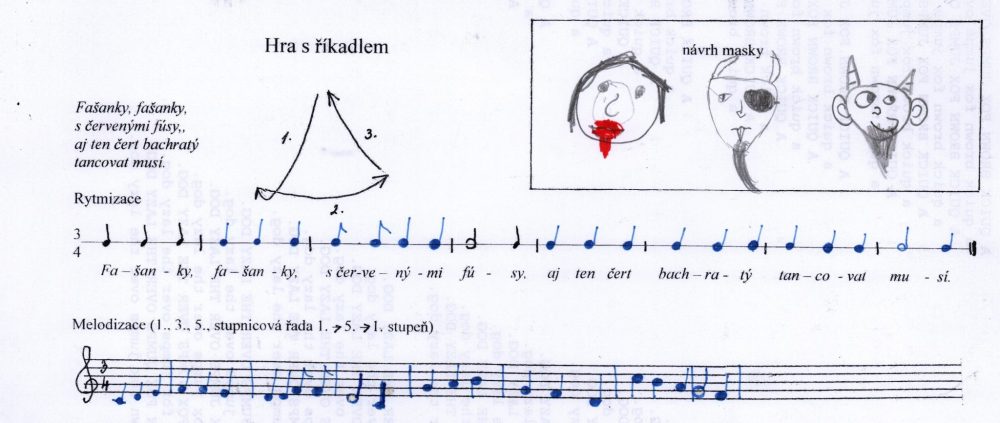Summary
With the period of finishing carnival, a various spectrum of custom manifestations are connected which include the area of folk verbal art, songs and dances, instrumental music and theatre. The process of maintaining traditional masks and props and production of new objects is accompanied by art, handmade etc. activities. The semantic file of some manifestations relates to the area of folk faith and superstitiousness. All the mentioned areas create inspirational field for creative activities of pupils.
Several carnival songs and melodies are connected with the dance pod šable (under swords) which is maintained in three villages of the Uherskobrodský Region
In this block we mainly deal with a rhythmical side of a dance song Pod šable, pod šable (south-east Moravia) and its movement interpretation. Another important part of the activities is rhythmization, melodization and instrumentation of the chosen texts of carnival songs or melodies. These creative activities of children will be accompanied by bear game which is thematically connected with the carnival. It might be placed at the end or beginning of the activities in the lesson. All interpretational files (vocal, instrumental, movement) and listening activities are interconnected while working with dance songs and literary texts. Creative elements penetrate the texts being set to music, improvisation of instrumental accompaniment to song and its dance expression.
References: Module 2,
Duration: 90 min
Key words creativity & entrepreneurship: Working in teams (music groups), Originality of ideas, Flexibility, Flow of ideas, Enthusiasm, Imagination, Transformation in organization
Description
Step 1
The thematic unit focused on folk ceremony connected with carnival rounds is introduced by a Moravian song Pod šable, pod šable played by a cimbalom band. The pupils listen to it, the practice of imitations follows.

Phonetic transcription: /pɔd ʃablɛ pɔd ʃablɛ aj pɔd ɔbʊʃkɪ mɪ fʃɛckɔ bɛrɛmɛ aj planɛ: hrʊʃkɪ/
Step 2
After learning the song, it is possible to accompany it by movement. The pupils first sing and clap rhythmical figures in the circle, then they improvise movement with beating out rhythm with swords according to music and own imagination.
Step 3
The pupils are divided into 4 groups; each has a different text of the song or rhyme.
The texts of folk songs or rhymes:
- Fašanky, fašanky, s červenými fúsy, aj ten čert bachratý tancovat musí./faʃankɪ faʃankɪ s tʃɛrvɛni:mɪ fu:sɪ, aj tɛn tʃɛrt baxrati: tancɔvat mʊsí:/
- Medvěde, medvěde, nosíš kabát chlupatý. Paňmáma tě povede, tančí po dvou jako ty (2/4 or 3/4 time)./mɛdvjɛdɛ mɛdvjɛdɛ nɔsi:ʃ kaba:t xlʊpati. Paɲma:ma tjɛ pɔvɛdɛ tantʃi: pɔ dvɔʊ jakɔ tɪ/
- Smažte šišky a koblížky, ať jsou červený jak lišky. A nám taky dejte, s námi počítejte./smaʒtɛ ʃɪʃkɪ a kɔbli:ʒkɪ ac jsɔʊ tʃɛrvɛni: jak lɪʃkɪ a na:m takɪ dɛjtɛ s na:mɪ pɔtʃi:tɛjtɛ/
- Tady nám nedali, tady nám dajú, zabili komára, slaniny majú./tadɪ na:m nɛdalɪ tadɪ na:m daju: zabɪlɪ kɔma:ra slanɪnɪ maju:/
(see the worksheets for the pupils no. 1–5, M2B1PL1-5e).
The process of the work with the text:
- The pupils rhythmizise the words
- The pupils write the rhythmical figures into the methodological sheet; according to their own experience and imagination, they might draw suggestions of carnival costumes
- The pupils melodise the text within the chosen tone space – 1st, 3rd, 5th grade, scale row 1st – 5th grade (see the graphic records of children in the worksheet for the pupils).
Step 4
The pupils create the accompaniment using rhythmical and melodic percussions from Orff instruments. If there are children in the group who can play a classical music instrument, they might use them.
The example of the work with Czech texts in French speaking children.
Step 5
Every group represents the melodised text.
We interconnect the melodised texts with the song Pod šable – we create a rondo form (Pod šable, pod šable, aj pod obušky – the main theme a, the rhymes are the couplets b, c …)
Step 6
Individual and collective reflection:
The pupils evaluate the different arrangements of rhymes, they try to describe which activity was the most difficult – whether melodization, rhythmization or accompaniment by playing musical instruments.
Step 7
In bear play we remind one of the carnival costumes.

Phonetic transcription: /ska:kej mɛdvjɛdɛ, tʃɛrt prɔ tɛ jɛdɛ. S dra:tɔvani:m mjɛxɛm, stɔji: za or̝̊ɛxɛm. Hʊja hʊja ja, ba:bɪ dɔ xli:va/
- Song practice
- Movement expression – the pupils move in a circle, one of them in the middle of the circle imitates a bear by improvisational movements according to music
Competencies
The pupils are able to:
- mastered the 2/4 and 3/4 time, they respond with the body play, they rhythmizise and melodise the text of the rhyme, they interconnect the creative skills with Orff instruments play
- be led to the development of the sense of a music form
- feel safe in the tone space of the 1st, 3rd, 5th grade and in a row scale of five tones
- create and write a melodic-rhythmical motive (and then sing it and play)
Materials
The note record of the song Pod šable, pod šable
The note record of the song Skákej, medvěde
The worksheets for the pupils: M2B1PL1-5e
The record of the song Pod šable, pod šable played by Petr Galečka’s Cimbalom Band from the Horňácko Region
Module Overview |
